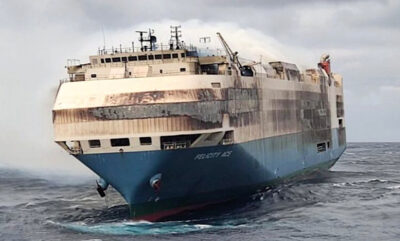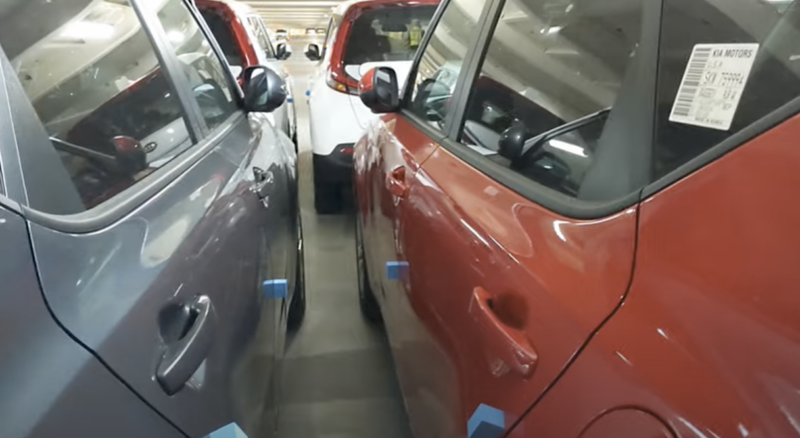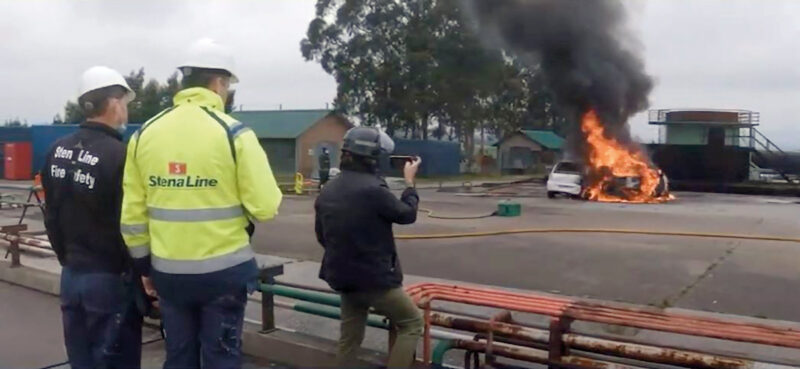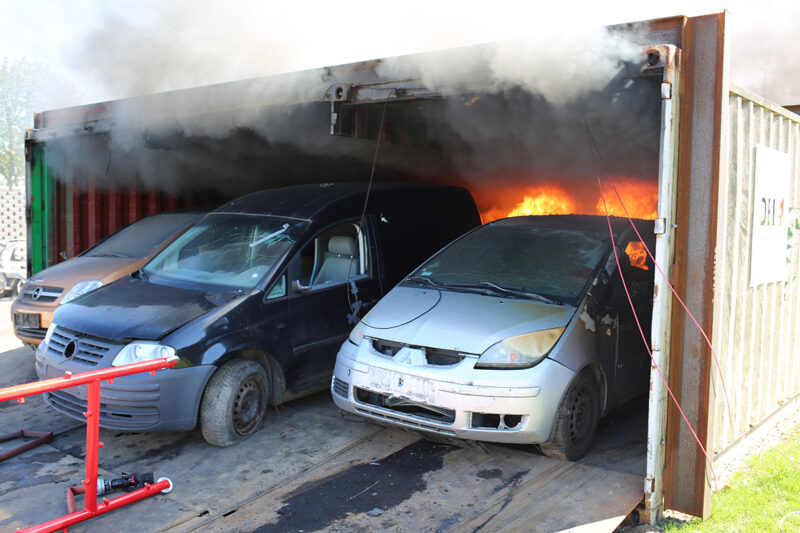https://www.bestmag.co.uk/much-to-learn-about-fighting-lithium-ion-battery-fires-at-sea/
Much to learn about fighting lithium-ion battery fires at sea
08 Feb 2023
Battery Research
By Andrew Draper
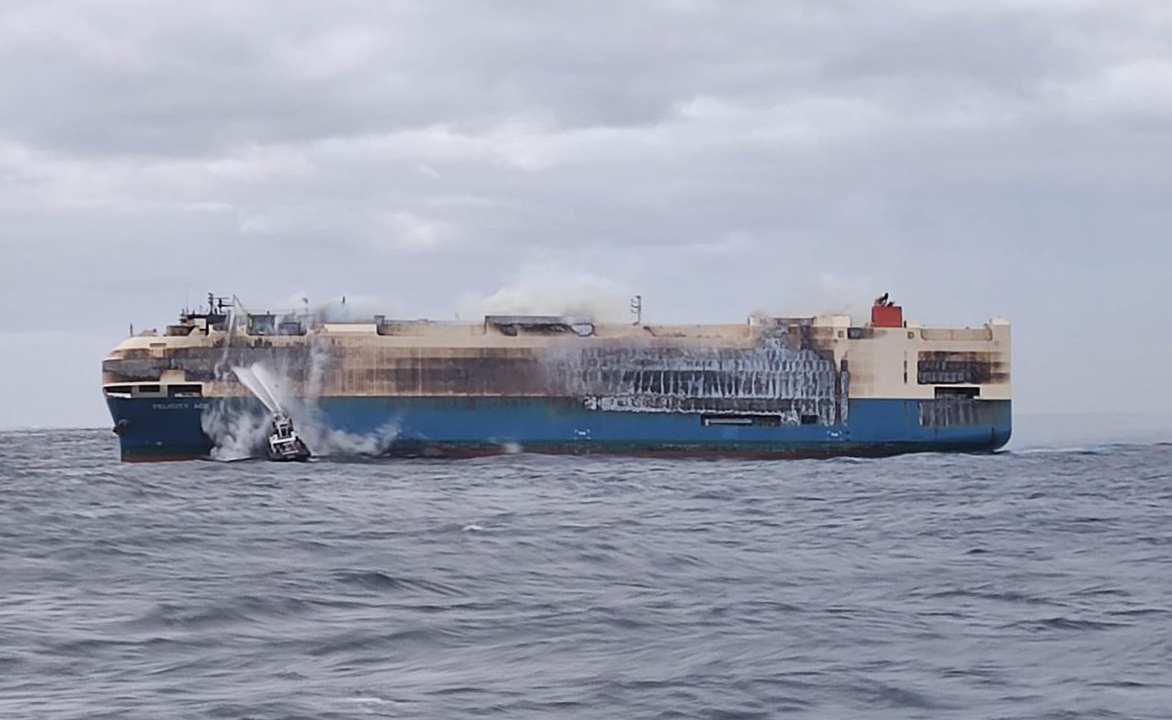
Shipowners and maritime industry leaders, insurers and consultants are working on response plans and training to make ship crews aware of the potential fire hazards of carrying electric vehicles fitted with lithium-ion batteries. Andrew Draper reports.
Car ferries – and multi-storey car parks for that matter – packed with EVs is “a huge risk and a disaster waiting to happen”, according to an industry consultant. YouTube and Twitter are awash with videos and photographs of electric vehicle (EV) fires, many of them hugely dramatic and spectacular. A lot of the fires are attributed to faults in lithium-ion batteries causing thermal runaway and developing very rapidly into blazes that can cause death and extensive destruction.
Felicity Ace car carrier
In February 2022, the 60,000gt car carrier, Felicity Ace, caught fire and burned for more than a week before recovery teams could board. The ship, which was en-route from Emden, Germany, to the US, sank while being towed and is now two miles beneath the surface of the Atlantic Ocean. The crew safely abandoned ship but the vessel’s cargo, almost 4,000 vehicles including Porsches, Audis and Bentleys worth an estimated $330 million, was lost. Anticipated wreck salvage costs mean total damages are expected to hit around $500 million.
Reuters reported that lithium-ion batteries in the EVs on board caught fire, though it is not known if they sparked the fire.
We know that tackling blazes poses enormous challenges to professional firefighters, who fight fires day in and day out. They’re getting to understand such fires but say there is much they don’t yet understand about how best to tackle them.
According to Brookes Bell, a UK-based multi-disciplinary technical and scientific consultancy to the maritime and energy industries, EV fires produce extremely hazardous vapours and shrapnel, secondary fires occur and there is risk of electrocution that may lead to serious injury or death.
Graeme Warnell
Graeme Warnell of GW Environmental & Consulting says while an internal combustion engine (ICE) car will burn at 800°C, an EV will burn at 1600°C. That also entails:
Dealing with this on land is one thing, but on board a ship at sea is quite something else. Imagine a packed vehicle deck, where moving equipment around is difficult; the lights might have gone out leaving the scene in darkness and dense smoke containing toxic gas is swirling. Add vehicle tyres exploding all around, and it makes for a potentially terrifying scenario. And the firefighters are actually seafarers who have been on a limited number of fire-fighting courses. It was reported that on Felicity Ace everything five metres above the water line was burning from one end of the 200-metres long ship to the other.
- 100+ organic chemicals are generated, including hydrogen cyanide
- 10,000+ litres of water are needed to suppress an EV fire
- Firewater will contain a cocktail of harmful chemicals and heavy metals.
Cars parked on a car carrier ship are too close to move between even without fire equipment.
Adrian Scales, a former captain with P&O Ferries and now Director of Nautical at Brookes Bell, told BEST:
“You have the battery going up in flames and the water draining away. It’s all well and good having this incident on shore where people can hopefully walk away. But when you’re on a ship it’s a different kettle of fish.”
Educating the industry
Brookes Bell has been raising awareness of the challenges with a series of presentations to insurers, shipowners and the wider maritime community over the last 12months. “There is a concern in the maritime industry with the carriage of these batteries, particularly in the ro-pax, pure car and truck carrier, and container markets. Most shipowners and industry leaders – insurers and other consultants etc. – are now working on response plans and training schedules to make their crews aware of the potential hazards.”
Adrian Scales
Scales has dealt with fires on board during his career and says it generally takes 8–12 minutes for a well-trained crew to muster. A lithium-ion battery fire can develop in 1–2 minutes, so by the time the crew arrives it is too late. “So we’re trying to educate ships and external response crews that if you suspect you have a problem, hit it as quickly as possible.”
While EV fires are still quite rare, the growth in EV numbers means EV fires will become more prevalent and experts are still trying to work out how best to deal with them, said Scales. One suggestion going around is to load EVs into metal containers for sea voyages. “You can fit four EVs into a 40-foot metal shipping container. But you don’t have time on a normal ferry service. That would increase the transit time by a couple of hours,” Scales said.
Detection and containment is the priority on every vessel type so as to give the crew and external responders the ability to respond appropriately, he said.
Warnell, who spent 30 years in the oil and gas industry on mitigating risk of fires and explosions, among other things, said car ferries packed with EVs are “a huge risk and a disaster waiting to happen”. He added: “And if there are a lot of vehicles, typically higher specification, then they will contain a lot of titanium and aluminium. When you therefore get a liquid metal fire and apply water, the water molecules undergo separation into hydrogen and oxygen gas molecules so you are actually feeding the fire.”
He is working on a solution for tackling lithium-ion battery fires that can be stored on board ships, and in which water is pumped through a solution that encapsulates the water. It raises the temperature at which the water evaporates, so less water is required to fight the fire.
Risk of re-ignition – stranded energy
The National Fire Protection Association (NFPA), a non-profit organisation devoted to eliminating death, injury, property and economic loss due to fire, electrical and related hazards, warns of the risk of reigniting lithium-ion battery fires, sometimes days later.
Victoria Hutchison, a project manager at NFPA’s affiliate, the Fire Protection Research Foundation, addressed the question in relation to Felicity Ace in an interview on the NFPA website: “Once an electric vehicle’s battery pack has been damaged by heat from a fire or water from suppression activities, this can leave the batteries in a damaged state.
“Just because it’s damaged doesn’t mean all the energy within the battery pack is gone. This can pose delayed hazards, particularly when removing the vehicles from the vessel, and this should definitely be accounted for and monitored.”
Energy essentially remaining trapped inside batteries is a phenomenon known as stranded energy, Hutchison explained, and it’s why fires involving EVs have been known to reignite after initially being suppressed.
LASH Fire tests on fire fighting electric cars.
Fire testing
LASH Fire is an EU-funded research project aiming to significantly reduce the risk of fires on board ro-ro ships. Its research shows that fires in ro-ros are far more frequent than on other ship types. The project consists of 27 research and industry partners from 13 EU member states and will run to August 2023.
In March 2022 a number of LASH Fire project members from DFDS, Stena, Fire Research of Norway and RISE went to Jovellanos Maritime Training Centre in Spain to perform full-scale fire tests on EVs with lithium-ion batteries.
Three different tests were conducted. They found the use of fire blankets to cover burning vehicles was an effective suppressant, as was use of fognails. They spray water through a rod-like device to cool smoke and hot surfaces (underneath car bonnets, for example) without adding oxygen to the fire by opening doors or bonnets.
The project found that hydrogen fluoride is detected in higher quantities in EV fires, so staying out of the smoke plume and wearing adequate personal protective equipment is important. Thermal runaway events are difficult to extinguish unless fire-fighting agent is injected into the battery. Fires do not usually start in the traction battery, so fast fire suppression to stop the fire spreading to the battery and adjacent vehicles are encouraged, it said.
Battery management systems isolate the battery after a collision or short circuit. This makes electric shock very unlikely while fighting fire with water, the project found.
Martin Carlsson, fire safety project manager at Swedish ferry company Stena Line, said fires on ferries are increasing “day by day”. He added: “Battery fires are hard to initiate and predict, but we do think we managed to create representative cases for the purpose. It was really good to see our crew members getting hands-on with these cars. Very few get this chance in reality.”
Danish testing: EV fires on ferries “not to be feared”
Danish fire safety institute DBI launched a project in 2021 on how best to deal with EV fires on board ships. Final conclusions are not yet in, but DBI believes EV fires on ferries are “not to be feared” and can be dealt with using the correct technology, education of crews and well coordinated cooperation with emergency services on land.
Its project, Electric Vehicle Fires at Sea: New Technologies and Methods For Suppression, Containment, and Extinguishing of Battery Car Fires On Board Ships (ELBAS) confirmed:
DBI says water mist from sprinklers is highly effective, not at putting the fires out, but at stopping them from spreading, giving crews time to access fires and put them out in a traditional way.
- Batteries give off toxic gases
- Lithium-ion battery fires can be difficult to put out
- In some cases, EV fires spread very rapidly from car to car.
A fire set up in a shipping container to simulate an on-ship situation with limited access in a confined space. Pic: DBI.
Carsten Møller, Business Development Specialist Maritime and Power-to-X at DBI – the Danish Institute of Fire and Security Technology – said realistic training of ship crews is essential. “In general you could say that we would recommend that on the basis of the project, crew members should do realistic tests – or realistic drills – to actually try the difference between a conventional car fire and EV fire, for instance.”
The project is providing methods and materials. It is working with local first responders to transfer and develop existing knowledge of EV-specific fire-fighting ashore to the maritime sector. The overall goal, it said, is to present new, holistic fire-fighting strategies for EV battery fires at sea. The project will also work to increase awareness of the complexity of EV battery fires.
DBI is leading and coordinating the project, run in close collaboration with Danish shipowning companies DFDS, Scandlines, Molslinjen, and with the Danish Emergency Management Agency.
Testing was carried out using three 40-foot containers, designed to simulate a car ferry deck. The Danish Emergency Management Agency concluded last year that there is less risk of fire with hybrid cars or EVs than ICE vehicles. But when it happens, lithium-ion battery fires can be more difficult to put out and may flare up repeatedly after being extinguished.
Alexander Kleiman, Maritime R&D Project Manager at DBI Advanced Fire Engineering and manager of the ELBAS project, said: “We found that how fires develop was very different, even though we had the same set-up from test to test. For example, in our fourth test, fires had spread to the other cars after two minutes. But that’s also reality – no two fires are ever entirely the same.”
Battery packs are typically placed in the bottom of cars. There was a fear the heat of a burning EV could melt aluminium decks. But the tests showed the heat generated from the bottom of a car is not initially as intense as anticipated and decks were left with barely a mark after an hour’s EV fire.
Initial indications from the project are that modern battery packs are much more fire-safe than older ones. Kleiman said: “Firstly, the battery pack in a new electric car is significantly more fireproof than in an old one. When we short-circuited the battery cells in a Renault Fluence, the whole battery caught fire. When we ignited it in a newer Tesla model 3, only the battery cell affected caught fire.”
The team believes that EV fires on ferries are “not to be feared” and can be dealt with using the correct technology on board, education of crews and well coordinated cooperation with emergency services on land.
Advice from Tesla
EV maker Tesla has issued emergency response guidance on its Model S EV. High-voltage burning batteries release super-heated gases and toxic vapours. It states: “This release may include volatile organic compounds, hydrogen gas, carbon dioxide, carbon monoxide, soot, particulates containing oxides of nickel, aluminium, lithium, copper, cobalt, and hydrogen fluoride.” Responders should always protect themselves with full PPE, including self-contained breathing apparatus, and take appropriate measures to protect civilians downwind from the incident, it says.
An insurer’s perspective
Corporate insurer Allianz Global Corporate & Specialty said in a special bulletin on lithium-ion batteries published in August 2022, Fire risks and loss prevention measures in shipping, that a lack of early detection on ships means a thermal runaway event is almost inevitable unless immediate action can be taken by crews to mitigate a fire. As that is rarely possible, the main focus should be on prevention.
Allianz identifies four main hazards associated with lithium-ion batteries: fire, explosion, thermal runaway and toxic gases. Their most common causes are substandard manufacture of battery cells/devices, over-charging of the battery cells, over-temperature by short circuiting, and damaged battery cells or devices.
The UN Manual of Tests and Criteria sets out a series of design tests that must be completed by manufacturers of lithium-ion batteries, and shipping companies should check for proof of test summaries, said Allianz. They cover state-of-charge (30-50% is ideal for transportation), short circuit compliance, and packing according to dangerous goods regulations.
IMO catching up
United Nations body the International Maritime Organisation is also turning its attention to the matter. Its Maritime Safety Committee considered a proposal at its 105th meeting in April 2022 to evaluate the adequacy of fire protection, detection and extinction arrangements to reduce the fire risk of ships carrying new energy vehicles. A sub-committee has been tasked with evaluating new measures needed for existing ships and to address charging of EVs on board vessels.
Solutions emerging
Fire-fighting solutions for use at sea are emerging. They include fire blankets, smaller diameter hoses, a pool set up around the vehicle to submerge the batteries, encapsulating foam, thermal measuring devices and fire detection measures. Some batteries are fitted with external vents, temperature sensors or flame-retardant electrolytes.
Residents evacuated as 100-ton lithium-ion fire rages for three days, page-64
Add to My Watchlist
What is My Watchlist?
